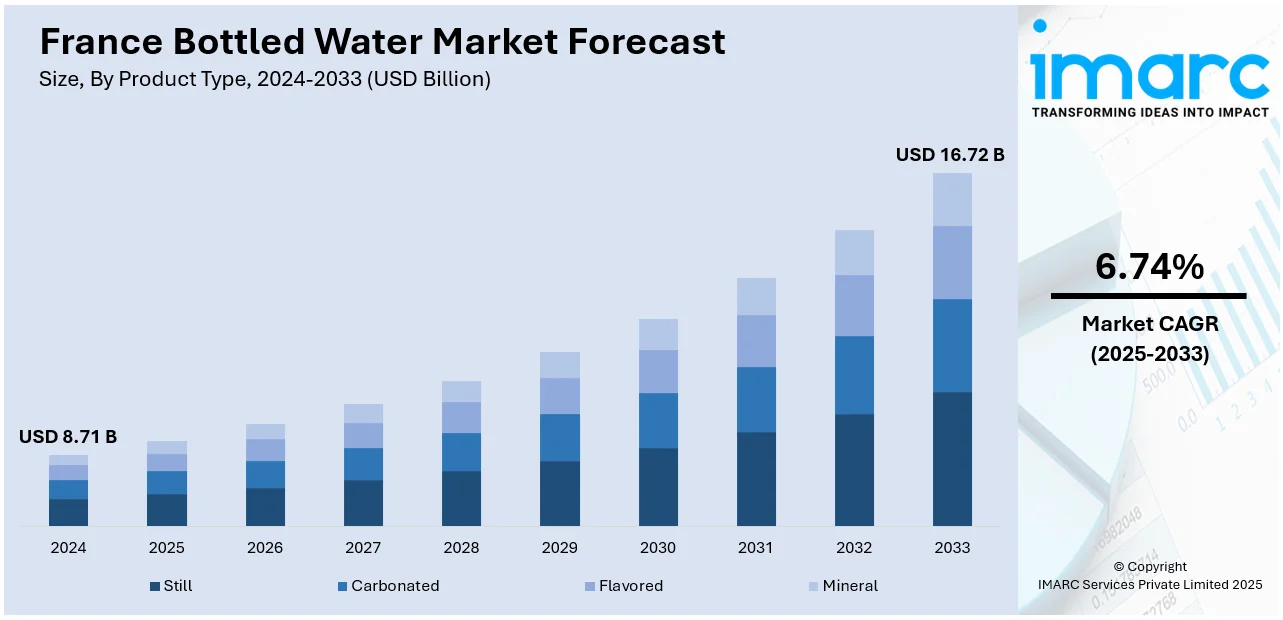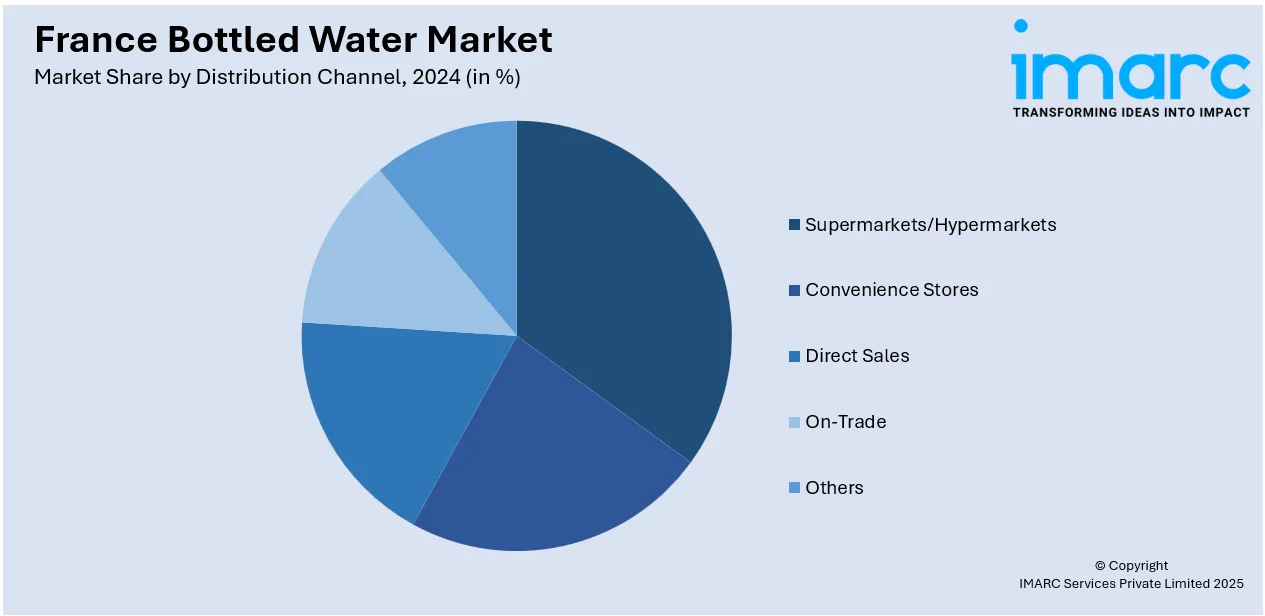
France Bottled Water Market Size, Share, Trends and Forecast by Product Type, Distribution Channel, Packaging Type, and Region, 2025-2033
France Bottled Water Market Overview:
The France bottled water market size reached USD 8.71 Billion in 2024. Looking forward, the market is expected to reach USD 16.72 Billion by 2033, exhibiting a growth rate (CAGR) of 6.74% during 2025-2033. The market is driven by rising health consciousness, growing preference for sugar-free beverages, and increasing demand for convenient hydration options. Sustainability trends are pushing brands toward eco-friendly packaging and local sourcing. Premium and flavored water segments are also gaining traction among urban consumers. These dynamics continue to shape the competitive landscape of the France bottled water market share.
|
Report Attribute
|
Key Statistics
|
|---|---|
|
Base Year
|
2024
|
|
Forecast Years
|
2025-2033
|
|
Historical Years
|
2019-2024
|
| Market Size in 2024 | USD 8.71 Billion |
| Market Forecast in 2033 | USD 16.72 Billion |
| Market Growth Rate 2025-2033 | 6.74% |
France Bottled Water Market Trends:
Health-Driven Consumer Preferences
The transition toward healthier living significantly influences the growth of the bottled water market in France. With increasing awareness regarding health issues such as obesity, diabetes, and the dangers associated with sugar, consumers are opting for natural bottled water over sugary sodas and artificially sweetened drinks. This change is most pronounced among urban and younger populations who prioritize hydration without the added calories. Bottled water is seen not merely as a drink but as a choice aligned with a health-focused lifestyle. In response, brands are ensuring clear labeling, disclosing mineral content, and embracing clean marketing strategies. The rise in demand for low-sodium, alkaline, and naturally balanced waters further supports this trend. As health and wellness culture grows in France consumption of bottled water is anticipated to increase steadily especially in the still, spring, and mineral categories.

To get more information on this market, Request Sample
Premium and Flavored Water Innovations
There is a notable surge in interest within the French bottled water market for premium and flavored options that offer benefits beyond mere hydration. Consumers are drawn to water products that are enriched with minerals, antioxidants, or functional additives like electrolytes and vitamins. This interest is driving product innovation, particularly among urban and health-oriented consumers who are seeking enhanced benefits and flavor experiences. Flavored waters infused with natural fruit essences, herbs, or botanicals are increasingly prominent on retail and hospitality shelves. Additionally, sparkling mineral water and high-end imported brands are becoming popular as lifestyle symbols. This trend of premiumization allows companies to distinguish themselves through branding, packaging, and unique ingredients, enabling higher profit margins while catering to the changing preferences of a more sophisticated customer base, which in turn, contributes positively to the France bottled water market growth.
Sustainable Packaging Advancements
Environmental sustainability is becoming a focal point for innovation in the bottled water industry in France. The public’s growing concern about plastic waste and carbon footprints is motivating brands to explore eco-friendly packaging options. Many companies are switching to bottles made from 100% recycled PET (rPET), biodegradable containers, or lighter packaging designs to minimize material usage. Additionally, some markets are testing refillable and returnable bottle systems. Brands are capitalizing on sustainability certifications, carbon-neutral strategies, and transparent sourcing practices to foster consumer trust. These efforts not only meet regulatory demands but also strongly appeal to environmentally aware consumers. As sustainability influences purchasing decisions, innovations in packaging are set to shape market positioning and competition, promoting ongoing developments throughout the French bottled water supply chain.
France Bottled Water Market Segmentation:
IMARC Group provides an analysis of the key trends in each segment of the market, along with forecasts at the country and regional levels for 2025-2033. Our report has categorized the market based on product type, distribution channel, and packaging type.
Product Type Insights:
- Still
- Carbonated
- Flavored
- Mineral
The report has provided a detailed breakup and analysis of the market based on the product type. This includes still, carbonated, flavored, and mineral.
Distribution Channel Insights:

- Supermarkets/Hypermarkets
- Convenience Stores
- Direct Sales
- On-Trade
- Others
A detailed breakup and analysis of the market based on the distribution channel have also been provided in the report. This includes supermarkets/hypermarkets, convenience stores, direct sales, on-trade, and others.
Packaging Type Insights:
- PET Bottles
- Metal Cans
- Others
The report has provided a detailed breakup and analysis of the market based on the packaging type. This includes PET bottles, metal cans, and others.
Regional Insights:
- Paris Region
- Auvergne-Rhône-Alpes
- Nouvelle-Aquitaine
- Hauts-de-France
- Occitanie
- Provence-Alpes-Côte d’Azur
- Grand Est
- Others
The report has also provided a comprehensive analysis of all the major regional markets, which include Paris Region, Auvergne-Rhône-Alpes, Nouvelle-Aquitaine, Hauts-de-France, Occitanie, Provence-Alpes-Côte d’Azur, Grand Est, and others.
Competitive Landscape:
The market research report has also provided a comprehensive analysis of the competitive landscape. Competitive analysis such as market structure, key player positioning, top winning strategies, competitive dashboard, and company evaluation quadrant has been covered in the report. Also, detailed profiles of all major companies have been provided.
France Bottled Water Market News:
- In June 2025, Nestlé received approval from the Vosges prefecture in France to begin exploratory water borehole drilling for its Hépar mineral water brand. The project must start within three years and includes geological assessments. Recent droughts prompted Nestlé to halt extractions from two wells, with further appeals possible regarding the decision.
France Bottled Water Market Report Coverage:
| Report Features | Details |
|---|---|
| Base Year of the Analysis | 2024 |
| Historical Period | 2019-2024 |
| Forecast Period | 2025-2033 |
| Units | Billion USD |
| Scope of the Report |
Exploration of Historical Trends and Market Outlook, Industry Catalysts and Challenges, Segment-Wise Historical and Future Market Assessment:
|
| Product Types Covered | Still, Carbonated, Flavored, Mineral |
| Distribution Channels Covered | Supermarkets/Hypermarkets, Convenience Stores, Direct Sales, On-Trade, Others |
| Packaging Types Covered | PET Bottles, Metal Cans, Others |
| Regions Covered | Paris Region, Auvergne-Rhône-Alpes, Nouvelle-Aquitaine, Hauts-de-France, Occitanie, Provence-Alpes-Côte d’Azur, Grand Est, Others |
| Customization Scope | 10% Free Customization |
| Post-Sale Analyst Support | 10-12 Weeks |
| Delivery Format | PDF and Excel through Email (We can also provide the editable version of the report in PPT/Word format on special request) |
Key Questions Answered in This Report:
- How has the France bottled water market performed so far and how will it perform in the coming years?
- What is the breakup of the France bottled water market on the basis of product type?
- What is the breakup of the France bottled water market on the basis of distribution channel?
- What is the breakup of the France bottled water market on the basis of packaging type?
- What is the breakup of the France bottled water market on the basis of region?
- What are the various stages in the value chain of the France bottled water market?
- What are the key driving factors and challenges in the France bottled water market?
- What is the structure of the France bottled water market and who are the key players?
- What is the degree of competition in the France bottled water market?
Key Benefits for Stakeholders:
- IMARC’s industry report offers a comprehensive quantitative analysis of various market segments, historical and current market trends, market forecasts, and dynamics of the France bottled water market from 2019-2033.
- The research report provides the latest information on the market drivers, challenges, and opportunities in the France bottled water market.
- Porter's five forces analysis assist stakeholders in assessing the impact of new entrants, competitive rivalry, supplier power, buyer power, and the threat of substitution. It helps stakeholders to analyze the level of competition within the France bottled water industry and its attractiveness.
- Competitive landscape allows stakeholders to understand their competitive environment and provides an insight into the current positions of key players in the market.
Need more help?
- Speak to our experienced analysts for insights on the current market scenarios.
- Include additional segments and countries to customize the report as per your requirement.
- Gain an unparalleled competitive advantage in your domain by understanding how to utilize the report and positively impacting your operations and revenue.
- For further assistance, please connect with our analysts.
 Request Customization
Request Customization
 Speak to an Analyst
Speak to an Analyst
 Request Brochure
Request Brochure
 Inquire Before Buying
Inquire Before Buying




.webp)




.webp)












